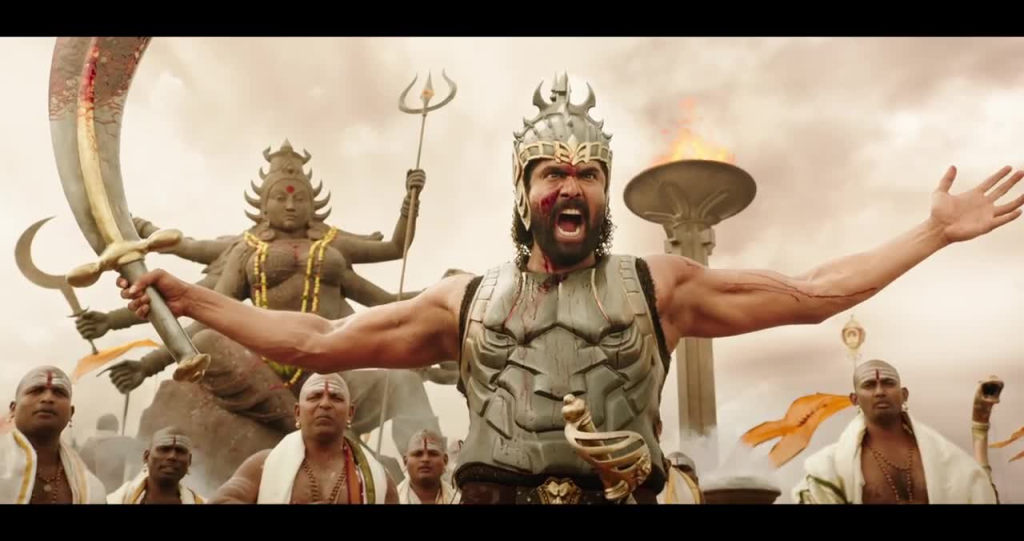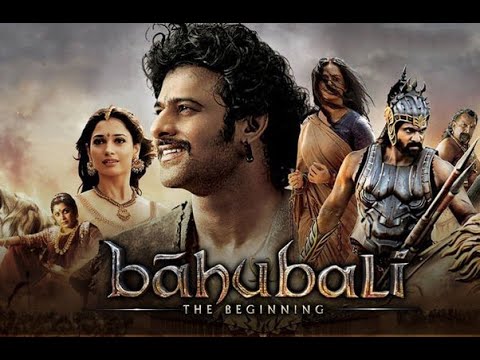Baahubali, released in two parts—Baahubali: The Beginning in 2015 and Baahubali: The Conclusion in 2017—became one of the most iconic and popular films in Indian cinema. Directed by S.S. Rajamouli and starring Prabhas, Rana Daggubati, Anushka Shetty, and Tamannaah, the film combines grand storytelling, stunning visuals, and epic action to narrate a saga of heroism, loyalty, and the triumph of good over evil. Set in the fictional kingdom of Mahishmati, Baahubali is the tale of two generations embroiled in a bitter power struggle, woven around themes of justice, sacrifice, and destiny. The film not only became a blockbuster in India but also garnered a massive fanbase worldwide, breaking box office records and leaving a lasting cultural impact.

The story begins in Baahubali: The Beginning, where the audience is introduced to a young man named Shivudu, raised in a humble village by his adoptive mother. Drawn to a mysterious waterfall and filled with a deep desire to explore beyond his world, Shivudu scales the waterfall and finds himself in the kingdom of Mahishmati, where he meets Avanthika, a fierce warrior fighting to free her imprisoned queen, Devasena. Over time, Shivudu learns of his royal lineage and true identity as Mahendra Baahubali, the son of Amarendra Baahubali, a beloved and noble king who was betrayed and murdered. This revelation propels Shivudu into a journey to reclaim his legacy, avenge his father’s death, and restore justice to Mahishmati by confronting his cousin, Bhallaladeva, who seized the throne through deception.

Baahubali: The Conclusion delves into Amarendra Baahubali’s past, revealing how he was destined to be the king of Mahishmati but was eventually betrayed. Amarendra’s cousin, Bhallaladeva, fueled by jealousy and ambition, manipulated the queen mother, Sivagami, into ordering Amarendra’s death. Kattappa, the loyal general who was forced to kill Amarendra out of duty to the throne, becomes a central character as the mystery of Amarendra’s death is unraveled. Meanwhile, Mahendra Baahubali, now aware of his lineage, returns to Mahishmati to challenge Bhallaladeva and avenge his father. The film reaches its climax in an epic battle, where Mahendra, embodying the strength, values, and courage of his father, ultimately defeats Bhallaladeva, restoring peace and justice to the kingdom.
Baahubali was watched by millions and became an international sensation for a variety of reasons. First and foremost, the film’s production scale was unprecedented in Indian cinema, with Rajamouli creating an entire fantasy world that rivaled Hollywood in scope and detail. The breathtaking visuals, grand sets, intricate costumes, and meticulously crafted battle sequences provided audiences with an immersive experience. Mahishmati, with its towering architecture and sweeping landscapes, felt like a living, breathing kingdom, captivating viewers and drawing them into its world. Baahubali raised the bar for Indian filmmaking, demonstrating that Indian cinema could produce films with the same technical quality and grandeur as global blockbusters.

The story itself, rooted in themes from Indian mythology and folklore, also resonated deeply with audiences. Baahubali’s tale of royal intrigue, betrayal, and justice is a timeless narrative that explores universal themes of honor, family loyalty, and the pursuit of righteousness. The characters, particularly Amarendra and Mahendra Baahubali, embody virtues such as compassion, strength, and self-sacrifice, making them heroic figures that audiences could admire and root for. Bhallaladeva, as a ruthless antagonist driven by jealousy, created a compelling contrast, adding tension and drama to the story. The moral dilemmas faced by characters like Kattappa and Sivagami brought depth to the narrative, highlighting the complexities of loyalty and duty in a power-driven world.

One of the reasons Baahubali captivated audiences was its mystery. The question “Why did Kattappa kill Baahubali?” became a national obsession, sparking countless theories and discussions. This cliffhanger ending to Baahubali: The Beginning not only intrigued audiences but also created an unprecedented level of anticipation for the sequel, making Baahubali: The Conclusion one of the most anticipated films in Indian cinema history. This suspenseful storytelling kept viewers engaged and excited, building a community of fans eager to uncover the truth behind the tragic fate of Amarendra Baahubali.
Baahubali carried powerful messages that resonated with the values and ideals of its audience. The character of Amarendra Baahubali represented the qualities of an ideal leader—selfless, just, and devoted to the well-being of his people. His actions, whether on the battlefield or in the kingdom, illustrated the responsibilities and sacrifices that come with power. Through Amarendra’s story, Baahubali celebrated the values of integrity, humility, and the belief that true greatness lies in serving others. His willingness to sacrifice his personal comfort and happiness for the greater good made him a role model and conveyed that leadership is about more than just wielding power; it is about embodying honor and compassion.

The film also made a strong statement about gender roles, with characters like Devasena and Sivagami standing out as powerful women who played central roles in the kingdom’s fate. Devasena’s character, portrayed by Anushka Shetty, broke stereotypes by challenging injustice and fiercely defending her beliefs. Her strength and resilience made her an inspirational figure, showing that women in Indian cinema could be portrayed as both courageous and morally grounded. Sivagami, as the queen mother and regent, wielded considerable authority and made complex decisions, highlighting that women could hold power and be central to the story’s progression. Baahubali’s portrayal of these strong female characters inspired audiences and set a new precedent for Indian cinema, encouraging filmmakers to create more multidimensional roles for women.
The cultural impact of Baahubali was profound, both in India and abroad. The film transcended regional and linguistic boundaries, as it was released in multiple languages and received acclaim from audiences across India. It set a new standard for “pan-Indian” cinema, demonstrating that films from any region in India could find nationwide appeal if they offered compelling stories and high production values. Baahubali’s success inspired other filmmakers to create films that appealed to a broader, pan-Indian audience, paving the way for a new era in Indian cinema that emphasizes unity in diversity.

Baahubali also had a significant impact on the film industry’s approach to visual storytelling, special effects, and production design. Its success proved that Indian audiences were ready to embrace grand narratives with high production standards, encouraging studios to invest more in visual effects, innovative storytelling, and high-quality filmmaking. This shift influenced a wave of Indian films with epic themes and cutting-edge technology, raising the bar for the entire industry and making Indian cinema more competitive on the global stage.

The film’s cultural legacy extended beyond the screen, inspiring a range of merchandise, comic books, and even an animated series. Baahubali became a household name, with its characters, music, and iconic scenes becoming part of popular culture. Fans of the movie celebrated its success through fan art, cosplay, and social media communities, keeping the spirit of Baahubali alive and creating a global fandom. The story’s exploration of timeless themes—such as the struggle for justice, the bond between family, and the sacrifices made for one’s people—made it resonate across generations, cementing Baahubali as a classic.
In conclusion, Baahubali is much more than just a movie; it is a cultural landmark that redefined Indian cinema. Through its grand storytelling, breathtaking visuals, and universal themes, Baahubali captured the hearts of audiences worldwide and set a new standard for Indian films. It showed that Indian cinema could tell epic stories on a massive scale, blending traditional values with modern filmmaking techniques to create a timeless experience. The film’s exploration of courage, sacrifice, and loyalty inspired viewers and left a lasting impact on the industry, encouraging filmmakers to aim higher and think bigger.
With its enduring appeal and powerful themes, Baahubali continues to be celebrated as one of the most iconic films in Indian cinema. Its influence is seen in the rise of pan-Indian films, the shift toward high-quality productions, and the portrayal of strong female characters. Baahubali remains a testament to the power of storytelling, proving that well-crafted cinema can transcend cultural barriers, inspire audiences, and leave a lasting legacy. The story of Mahishmati and the heroic journey of Baahubali will continue to inspire generations, reminding them of the values of justice, integrity, and the courage to fight for what is right.









